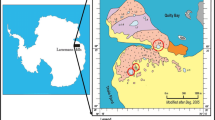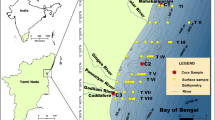Abstract
The sediment cores of 20 cm length collected from 31 to 83 m range of water depth from the inner shelf of Bay of Bengal west of “Swatch of No Ground” were analyzed for grain size, organic carbon, total nitrogen, calcium carbonate and clay mineralogy. Grain size analysis revealed that the sediment size decreases from west to east within the study area indicating a possible direction of transport towards east parallel to the coast. The grain size also decreases with increasing water depth, i.e. north to south, indicating sediment contribution to the area of study from Hooghly and other local rivers. In the cores studied, illite was the dominant clay mineral which seems to be a product of glacial weathering under arid conditions with its source being the Himalayan region. The organic carbon content was low in the sediments and was attributed to low plankton production or intense oxidation processes. Low calcium carbonate percentage also supports the view of a low productivity in this region. Organic carbon increases gradually from west to east indicating its association with finer sediments and also indicates transport due to currents which drift the organic carbon away before it settles down within the sediments. Higher values relatively closer to the coast in the eastern side indicate additional contribution from Sunderban mangroves. The C/N ratio obtained indicates mixed source of terrestrial and marine for the organic matter in the sediments. Sedimentation rates available for deltaic plains and shelves off Bangladesh when adopted for the present area revealed that a 20 cm long sediment column was deposited in around 10 years. In most of the cores studied, a change in the trend of sediment components and organic carbon was observed at around 10 cm where grain size increases and organic carbon decreases towards the surface inferring that during the last 5 years, possible floods during NE monsoon or due to melting of ice in Himalaya are responsible for releasing additional water and material which brought a change in hydrodynamic conditions. The surface depletion of organic carbon indicates its dilution by the addition of coarser materials.





Similar content being viewed by others
References
Balakrishna K, Probst JL (2005) Organic carbon transport and C/N ratio variations in a large tropical river: Godavari as a case study, India. Biogeochemistry 73:457–473
Biscaye PE (1965) Mineralogy and sedimentation of recent deep sea clay in the Atlantic Ocean and adjacent seas and oceans. Geol Soc Am Bull 76:803–832
Chakraborty P, Sarkar A, Vudamala K, Naik R, Nath BN (2015) Organic matter—a key factor in controlling mercury distribution in estuarine sediment. Mar Chem 173:302–309
Chauhan OS, Rajawat AS, Pradhan Y, Suneethi J, Nayak SR (2005) Weekly observations and sink pathways of the terrigenous flux of the Ganges-Brahmaputra in the Bay of Bengal during NE monsoon. Deep-Sea Res II 52:2018–2030
Coleman JM (1979) Brahmaputra River: channel processes and sedimentation. Sed Geol 3:129–239
Datta DK, Subramanian V (1997) Texture and mineralogy of sediments from the Ganges-Brahmaputra-Meghna river system in the Bengal Basin, Bangladesh and their environmental implications. Environ Geol 30:181–188
Folk RL (1968) Petrology of sedimentary rocks. Hemphilis Austin 177
Galy V, Lanord CF, Lartiges B (2008) Loading and fate of particulate organic carbon from the Himalaya to the Ganga–Brahmaputra delta. Geochim Cosmochim Acta 72:1767–1787
Gireeshkumar TR, Deepulal PM, Chandramohanakumar N (2013) Distribution and sources of sedimentary organic matter in a tropical estuary, south west coast of India (Cochin estuary): a baseline study. Mar Pollut Bull 66:239–245
He M, Zheng H, Huang X, Jia J, Li L (2013) Yangtze River sediments from source to sink traced with clay mineralogy. J Asian Earth Sci 69:60–69
Hedges JI, Keil RG (1995) Sedimentary organic matter preservation: an assessment and speculative synthesis. Mar Chem 49:81–115
Hedges JI, Clark WA, Quay PD, Richey JE, Devol AH, Santos M (1986) Compositions and fluxes of particulate organic material in the Amazon River 1. Limnol Oceanogr 31:717–738
Hu J, Peng PA, Jia G, Mai B, Zhang G (2006) Distribution and sources of organic carbon, nitrogen and their isotopes in sediments of the subtropical Pearl River estuary and adjacent shelf, Southern China. Mar Chem 98:274–285
Jasper JP, Gagosian RB (1990) The sources and deposition of organic matter in the Late Quaternary Pigmy Basin, Gulf of Mexico. Geochim Cosmochim Acta 54:1117–1132
Krishna MS, Naidu SA, Subbaiah CV, Sarma VV, Reddy NP (2013) Distribution and sources of organic matter in surface sediments of the eastern continental margin of India. J Geophys Res: Biogeosci 118:1484–1494
Kuehl SA, Hariu TM, Moore WS (1989) Shelf sedimentation off the Ganges–Brahmaputra river system: evidence for sediment bypassing to the Bengal fan. Geology 17:1132–1135
Liu Z, Colin C, Li X, Zhao Y, Tuo S, Chen Z, Siringan FP, Liu JT, Huang CY, You CF, Huang KF (2010) Clay mineral distribution in surface sediments of the northeastern South China Sea and surrounding fluvial drainage basins: source and transport. Mar Geol 277:48–60
Mallik TK (1976) Shelf sediments of the Ganges delta with special emphasis on the mineralogy of the western part, Bay of Bengal, Indian Ocean. Mar Geol 22:l-32
Meyers PA (1997) Organic geochemical proxies of paleoceanographic, paleolimnologic and paleoclimatic processes. Org Geochem 27:213–250
Michels KH, Suckow A, Breitzke M, Kudrass HR, Kottke B (2003) Sediment transport in the shelf canyon “Swatch of No Ground” (Bay of Bengal). Deep-Sea Res II 50:1003–1022
Mueller PJ (1977) C/N ratios in Pacific deep-sea sediments: effect of inorganic ammonium and organic nitrogen compounds sorbed by clays. Geochim Cosmochim Acta 41:765–776
Naidu PD (1991) Glacial to interglacial contrasts in the calcium carbonate content and influence of Indus discharge in two eastern Arabian Sea cores. Palaeogeog Palaeoclimat Palaeoeco 86:255–263
Noronha-D’Mello CA, Nayak GN (2015) Geochemical characterization of mangrove sediments of the Zuari estuarine system, West coast of India. Estuar Coast Shelf Sci. doi:10.1016/j.ecss.2015.09.011
Pradhan UK, Wu Y, Shirodkar PV, Zhang J, Zhang G (2014) Sources and distribution of organic matter in thirty five tropical estuaries along the west coast of India-a preliminary assessment. Estuar Coast Shelf Sci 151:21–33
Prahl FG, Ertel JR, Gonai MA, Sparrow MA, Eversmeyer B (1994) Terrestrial organic carbon contributions to sediments on the Washington margin. Geochim Cosmochim Acta 58:3048–3055
Premuzic ET, Benkovitz CM, Gaffney JS, Walsh JJ (1982) The nature and distribution of organic matter in the surface sediments of world oceans and seas. Org Geochem 4:63–77
Ramaswamy V, Gaye B, Shirodkar PV, Rao PS, Chivas AR, Wheeler D, Thwin S (2008) Distribution and sources of organic carbon, nitrogen and their isotopic signatures in sediments from the Ayeyarwady (Irrawaddy) continental shelf, northern Andaman Sea. Mar Chem 111:137–150
Rao VP, Rao BR (1995) Provenance and distribution of clay minerals in the sediments of western continental shelf and slope of India. Cont Shelf Res 15:1757–1771
Rao VP, Reddy NP, Rao CM (1988) Clay mineral distribution in the shelf sediments off the northern part of the east coast of India. Cont Shelf Res 8:145–151
Ruiz-Fernández AC, Marrugo-Negrete JL, Paternina-Uribe R, Pérez-Bernal LH (2011) 210Pb-derived sedimentation rates and Corg fluxes in Soledad Lagoon (Cispatá Lagoon system, NW Caribbean coast of Colombia). Estuar Coasts 34:1117–1128
Sarkar A, Chakraborty P, Nath BN (2015) Distribution and nature of sedimentary organic matter in a tropical estuary: an indicator of human intervention on environment. Mar Pollut Bull. doi:10.1016/j.marpolbul.2015.11.013
Sarma VV, Krishna MS, Prasad VR, Kumar BS, Naidu SA, Rao GD, Viswanadham R, Sridevi T, Kumar PP, Reddy NP (2014) Distribution and sources of particulate organic matter in the Indian monsoonal estuaries during monsoon. J Geophys Res: Biogeosci 119:2095–2111
Segall MP, Kuehl SA (1992) Sedimentary processes on the Bengal Continental Shelf as revealed by clay-size mineralogy. Cont Shelf Res 12:517–541
SubbaRao M (1960) Organic matter in marine sediments off east coast of India. Bull Am Assoc Petrol Geol 44:1705–1712
Suckow A, Morgenstern U, Kudrass R (2001) Absolute dating of recent sediments in the cyclone-influenced shelf area off Bangladesh: comparison of gamma spectrometric (137cs, 210pb, 228ra), radiocarbon, and 32si ages. Radiocarbon 43:917–927
Trask PD (1939) Organic content of recent marine sediments. Am Assoc Petro Geol 428–453
Volvoikar SP, Nayak GN, Mazumdar A, Peketi A (2014) Reconstruction of depositional environment of a tropical estuary and response of δ13Corg and TOC/TN signatures to changing environmental conditions. Estuar Coast Shelf Sci 139:137–147
Wahsner M, Müller C, Stein R, Ivanov G, Levitan M, Shelekhova E, Tarasov G (1999) Clay‐mineral distribution in surface sediments of the Eurasian Arctic Ocean and continental margin as indicator for source areas and transport pathways—a synthesis. Boreas 28:215–233
Yu F, Zong Y, Lloyd JM, Huang G, Leng MJ, Kendrick C, Lamb AL, Yim WWS (2010) Bulk organic δ13C and C/N as indicators for sediment sources in the Pearl River delta and estuary, southern China. Estuar Coast Shelf Sci 87:618–630
Acknowledgments
One of the authors (GNN), place on record, thanks to the Ministry of Earth Sciences, Govt. of India, for funding a research project under which this research was carried out. The authors thank Dr. Rajiv Nigam, Scientist, National Institute of Oceanography (NIO), Goa, Coordinator of the project for his continuous support, Dr. Rajeev Saraswat, Scientist, NIO, Goa for providing sediment core samples collected as a part of NIO’s GEOSINKS Project. Drs. Ramaswamy, C.P.Babu, Mr. Girish Prabhu and Director, NIO, Goa are thanked for kindly extending instrumental facilities of coulometer, C/N analyser and X-ray diffractometer.
Author information
Authors and Affiliations
Corresponding author
Rights and permissions
About this article
Cite this article
Bejugam, P., Nayak, G.N. Changing depositional environment revealed from sediment components, west of “Swatch of No Ground”, northern Bay of Bengal. Arab J Geosci 9, 551 (2016). https://doi.org/10.1007/s12517-016-2563-y
Received:
Accepted:
Published:
DOI: https://doi.org/10.1007/s12517-016-2563-y




